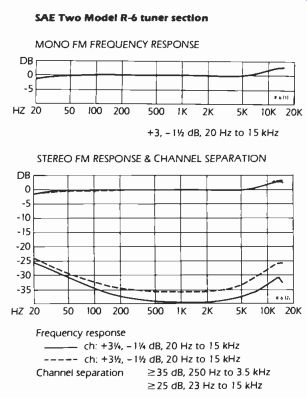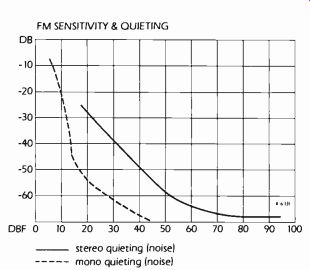SAE Two Is No "Me Too"

SAE Two Model R-6 tuner section
-----------------
Frequency response ch: +3 1/2,-1 1/2 dB, 20 Hz to 15 kHz ch: +3 1/2,-16 dB, 20 Hz to 15 kHz Channel separation >35 dB, 250 Hz to 3.5 kHz
.?_25 dB, 23 Hz to 15 kHz
stereo quieting (noise) mono quieting (noise)
Stereo sensitivity (for 50-dB noise suppression) 41 dBf at 98 MHz, with 0.36% THD+N (41 Y2 dBf at both 90 and 106 MHz)
Mono sensitivity (for 50-dB noise suppression) 1644 dBf at 98 MHz
Muting threshold Stereo threshold Stereo S/N ratio (at 65 dBf) 6644 Mono S/N ratio fat 65 dBf) 13 dBf 16 dBf dB 71 1/2 dB CAPTURE RATIO 114 dB ALTERNATE-CHANNEL SELECTIVITY 56 1/2 dB HARMONIC DISTORTION (THD+N) stereo at 100 Hz 0.21% at 1 kHz 0.065% at 6 kHz 0.14% STEREO PILOT INTERMODULATION IM DISTORTION (mono) AM SUPPRESSION PILOT (19 kHz) SUPPRESSION SUBCARRIER (38 kHz) SUPPRESSION mono
0.16%
0.046%
0.072%
0.074%
0.055% 653/4 dB 71 1/2 dB
>84 dB
SAE Two Model R-6 amplifier section
RATED POWER 17% dBW (60 watts)/ch.
OUTPUT AT CLIPPING (both channels driven) 8-ohm load 19 dBW (80 watts)/ch.
4-ohm load 201/2 dBW (115 watts)/ch.
16-ohm load 161/2 dBW (45 watts)/ch.
DYNAMIC HEADROOM (8 ohms) 21/2 dB HARMONIC DISTORTION (THD; 20 Hz to 20 kHz) at 17% dBW (60 watts) <0.01% at 0 (1 watt) <0.01% FREQUENCY RESPONSE
+0,-Y. dB, <10 Hz to 150 kHz,
-3 dB at 270 kHz
RIAA EQUALIZATION +1/2,-0 dB, 20 Hz to 20 kHz;
-544 dB at 5 Hz
INPUT CHARACTERISTICS (re 0 dBW; A-weighting) sensitivity S/N ratio phono 0.34 mV 75 1/2 dB aux 20 mV 76 1/4 dB PHONO OVERLOAD (1-kHz clipping) 220 mV
PHONO IMPEDANCE 35k ohms at 1 kHz (complex) DAMPING FACTOR (at 50 Hz) 115 LOW FILTER-3 dB at 30 Hz; 6 dB/octave
------------------



SAE Two Model R-6 stereo FM/AM receiver, in metal case with wood ends. Dimensions: 181/4 by 5% inches (front panel), 15 1/4 inches deep plus clearance for controls and connections. AC convenience outlets: two switched (600 watts max.), two unswitched (100 watts max.).
Price: $650.
Warranty: "limited," three years parts and labor. Manufacturer: made in Japan for Scientific Audio Electronics, Inc., 701 E. Macy St., Los Angeles, Calif. 90012.
You can count the number of domestically produced stereo receivers on the fingers of one hand and have digits left over. High-quality separates-including those on which SAE's reputation is based-are another matter, of course. But when a company like SAE wants to add receivers (or tape decks) to its line, competitive pricing virtually dictates Oriental manufacture. When SAE decided to build a line in Japan, it distinguished between its separates and the imports by calling the latter the SAE Two series.
The R-6 is the least expensive receiver in that line, but it offers such a slew of novelties and genuinely useful features that it sparks enthusiasm even in the stodgiest reviewers. In addition to familiar niceties like quartz-locked tuning and digital frequency readout, we have such features as switching for an external processor (equalizer, noise-reduction system, or the like) that not only leaves tape-monitor loops unencumbered, but can be switched into the circuit either ahead of the tape-output jacks or into the listening signal path. Thus the processor can be used either to "fix" a signal you are recording or for one you are playing back. The tape recordist used to re-plugging cables in order to achieve this flexibility will really appreciate the convenience. His needs have been anticipated further by two-way tape-dubbing independent of the main program selector and by a separate three way monitor switch so that the playback from either deck can be checked in a wink.
When you are dubbing between decks with EXT PROC in the TAPE position, the processor is switched into the line between the source deck and the slave. We can't remember a receiver whose tape switching logic is more complete or foolproof.
Frosting the tape recordist's cake are the signal displays; in one mode they function as eleven-segment fluorescent "bar graphs" to supplement the deck's own recording-level meters. In addition, the displays monitor output to the speakers (in 3-dB steps from 0.06 to 60 watts) and act as tuning "aids." In the power mode, Diversified Science Laboratories found all the display elements accurate within 1/4 dB, with essentially flat response across the audio band. Although the 3-dB steps are a bit crude for setting recording levels, the 30-dB range exceeds that of many recording indicators, and response time is faster than that of the meters in many decks. (Essentially, they respond accurately to any pulse lasting at least 20 milliseconds.) In its AM/FM mode, the display's upper bar graph indicates signal strength; the lower one serves as an FM-multipath indicator. When you're tuning and orienting your antenna, you should maximize the top reading and minimize the lower bar. In practice, the system works quite well: When we adjust the antenna for a maximum differential between the two bars, the sound is noticeably cleaner than with other readings. As a signal-strength indicator, the upper display distinguishes FM signal levels from 23 1/4 to 54 1/2 dBf (the most important range) in such detail that we find it among the most useful bar graphs we have encountered.
The R-6 requires a little more signal level than average to achieve the magic 50-dB quieting, but its ultimate quieting (with a 65-dB input) is up to snuff, and the audio distortion is low. Sensitivity is essentially constant across the band, and, as is to be expected, the digital display accurately indicates the tuned frequency. All of this is readily apparent when using the R-6. Reception of strong stations in our area is all that we could ask for, though weaker ones are a trifle noisier than usual. The high-blend option is reasonably effective in reducing hiss on stereo signals of marginal strength and actually flattens top-end response by comparison to the curve measured (with the BLEND off) by DSL and shown in our graph. Separation is better than 30 dB across the most important part of the band with the BLEND off and still an adequate 20 dB to about 2 kHz with it on. AM suppression is good and selectivity adequate for most situations.
The R-6 has no channel-center tuning meter, but its presence is not often missed: A TUNE LED lights when you are on your station's target. Releasing the knob at this point activates the station lock, indicated by a separate legend. In order for either indicator to come on, you must tune quite accurately, which takes some care in manipulating the very light tuning mechanism. In some instances apparently associated with very weak signals or with high multipath-the tuning indicator does not illuminate, and the receiver does not go into lock. Once in lock, however, the R-6 usually maintains a tenacious grip on the signal, even during fading.
The receiver is conservatively rated at 60 watts (17 3/4 dBW) per channel.
DSL found that it actually pumps out 80 watts per channel continuously into 8-ohm loads before clipping. Dynamically, it delivers the equivalent of 100 watts, for an exceptionally generous headroom of 2 1/4 dB. THD remains below 0.01% throughout the audio band at either the 1-watt or the rated-power level. The high damping factor testifies to the liberal use of feedback. With the tone controls bypassed, basic frequency response is virtually ruler flat to 150 kHz; with the tone controls in the circuit but at the nominal center points, the response is down about 1/2 dB at 20 Hz and 20 kHz. The infrasonic filter slope is mild.
Separate controls are provided for bass, midrange, and treble. The midrange is centered on 1.2 kHz but is effective over much of the band-between about 180 Hz and 7 kHz-and affords a maximum control range of +10 to-11 dB.
The shelving bass and treble controls overlap the midrange slightly; the bass picks up at 280 Hz, with +15 to-17 dB maximum (below 40 Hz), and the treble at 2.5 kHz, with +10 to-12 dB above 10 kHz. The loudness contour boosts both ends of the spectrum substantially: by 11 dB or more below 50 Hz and by more than 7 dB above 10 kHz-making the sound somewhat brighter than we like in a loudness contour.
The phono preamp is equalized accurately and has more than sufficient headroom. While its 1-kHz impedance is close to the nominal 47,000 ohms, DSL did not find a suitable value of resistance and capacitance that would model the complex load presented to the cartridge. Perhaps due to the "non-classic" loading, the disc-reproduction sound of the R-6 struck us as a bit brighter or edgier than average.
Whether from disc or from FM, this is a bright, clean-sounding receiver.
Its power reserves belie its modest ratings; indeed, the receiver acts and sounds both more powerful than its 60-watt rating would suggest and more sophisticated than its price tag would imply. The logical switching options almost put the R-6 in a class by itself and are sufficient reason to cast a careful eye on this SAE import.
(High Fidelity, Jan. 1980)
Also see:
Jensen System B loudspeaker (review, Jan. 1980)